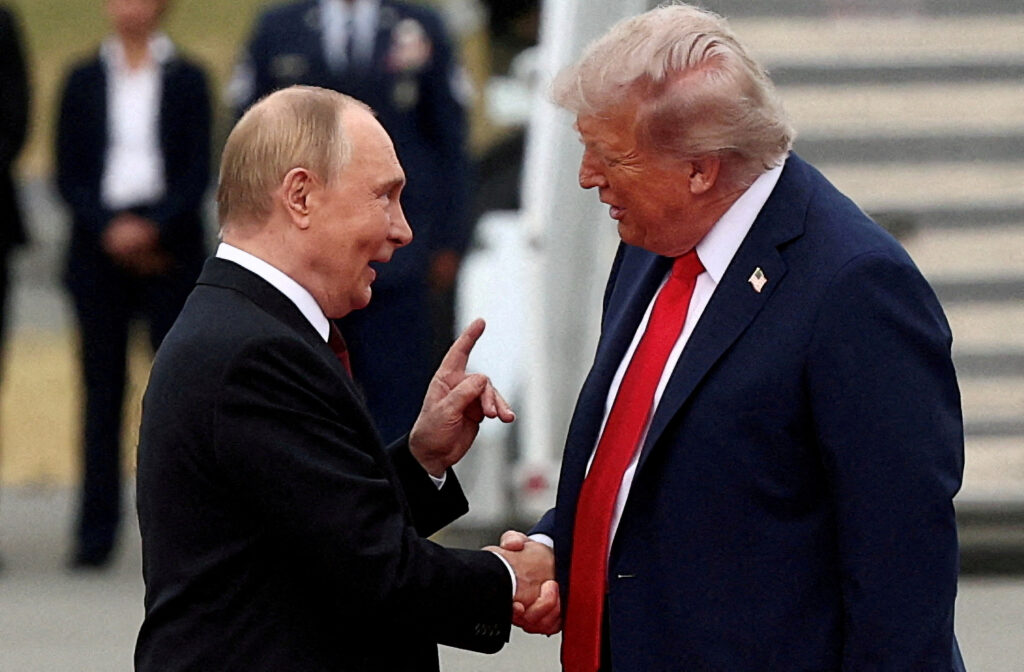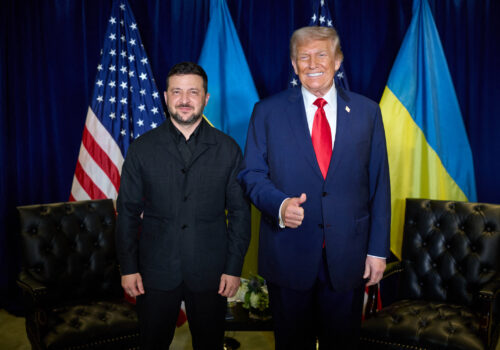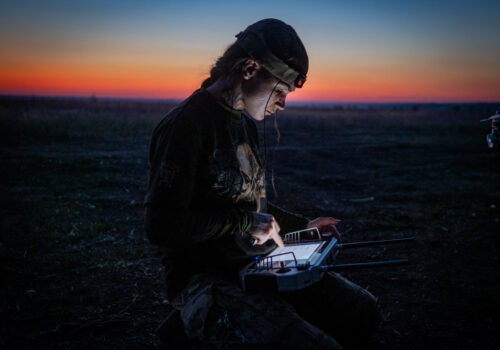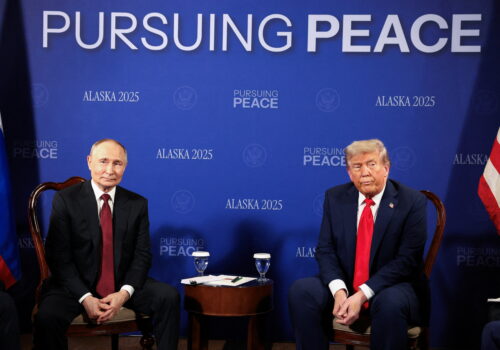As the United States moves closer to a decision on supplying Ukraine with Tomahawk missiles, the Kremlin is cranking up the rhetoric in a bid to deter US President Donald Trump. Commenting on Sunday, Russian President Vladimir Putin’s spokesman Dmitry Peskov acknowledged that the issue of Tomahawks was causing “extreme concern” in Moscow and said the war was now entering a “dramatic moment” with tensions escalating on all sides.
Others were even more outspoken. Former Russian President Dmitry Medvedev led the way with a thinly-veiled nuclear threat directed personally at Trump. “It’s been said a hundred times, in a manner understandable even to the star-spangled man, that it’s impossible to distinguish a nuclear Tomahawk missile from a conventional one in flight,” Medvedev noted. “The delivery of these missiles could end badly for everyone. And most of all, for Trump himself.”
Medvedev’s nuclear saber-rattling has been echoed by Belarusian dictator Alyaksandr Lukashenka. Long seen as Putin’s closest international ally and a junior partner in the Kremlin’s Ukraine invasion, Lukashenka warned this week that any decision to provide Kyiv with the US-made long-range missiles could have disastrous ramifications for international security. “Tomahawks will not solve the problem. They will escalate the situation to a nuclear war,” he told colleagues in Minsk.
It is easy to understand why Moscow so adamantly opposes the idea of sending Tomahawks to Ukraine. With a potential range of up to 2500 kilometers, these powerful missiles would make it possible for the Ukrainian army to radical expand their current campaign of long-range strikes against military and industrial targets deep inside Russia. Kyiv has already been able to significantly damage Putin’s war machine using domestically produced drones and missiles. There is now clearly a growing sense of alarm in Moscow that the additional firepower provided by American Tomahawks could tip the balance further in Ukraine’s favor.
The real question is whether Russia’s latest threats deserve to be taken seriously. After all, Kremlin officials have frequently used similarly apocalyptic language throughout the past three and a half years of full-scale war, but have consistently failed to back their words up with actions. Time and again, Moscow has declared a new red line while warning the West of potential Russian reprisals, only to then do nothing when these red lines are subsequently crossed.
Stay updated
As the world watches the Russian invasion of Ukraine unfold, UkraineAlert delivers the best Atlantic Council expert insight and analysis on Ukraine twice a week directly to your inbox.
Russia’s attempts to impose red lines on Ukraine’s Western allies are a key part of the intimidation tactics employed by Putin since the start of the war. During his address announcing the full-scale invasion of Ukraine, Putin threatened the West with “such consequences that you have never faced in your history” if they dared to intervene. This rather obvious reference to nuclear war set the tone for the relentless nuclear blackmail that has followed. When it became apparent last year that Putin’s nuclear bluster was losing its potency, he ostentatiously revised Russia’s nuclear doctrine to lower the threshold for nuclear strikes and heighten the fear factor throughout the democratic world.
Russia’s nuclear threats have certainly not been subtle, but they have proved surprisingly effective against risk-averse Western leaders. From the eve of the invasion onward, every single debate over the delivery of new weapons to Ukraine has been dragged out and delayed by overblown fears of possible escalation and craven talk of the need to avoid provoking Putin.
The timidity of the West has only served to embolden the Kremlin dictator and prolong the war, enabling Russia to punch well above its geopolitical weight against far wealthier and better armed opponents. Indeed, while his armies have struggled to advance on the battlefields of Ukraine, Putin’s ability to intimidate the West has been arguably his single biggest success of the entire invasion.
This success is all the more remarkable given how many times Putin’s threats have been exposed as empty. Russia’s unilaterally declared red lines over the supply of everything from Javelin anti-tank weapons and Patriot air defense systems to F-16 fighter jets and Leopard tanks have all eventually been violated without consequence. Likewise, the Ukrainian army has repeatedly demonstrated its complete disregard for Putin’s red lines by liberating large swathes of the country from Russian occupation, chasing the Russian Black Sea Fleet out of Crimea, and invading Russia itself.
None of this has sparked World War III. On the contrary, Putin has responded to each fresh military setback by attempting to downplay the significance of his latest humiliation. Russian retreats have been rebranded in Orwellian fashion as “goodwill gestures,” while earlier protests over the planned delivery of new weapons systems have been replaced by expressions of defiant indifference.
Eurasia Center events

Based on the wartime experience of the past three and a half years, there is no reason whatsoever to believe that Russia’s red lines are credible. Instead, the only logical conclusion is that Putin has been bluffing all along. Trump must now decide whether he will call Putin’s bluff and arm Ukraine with Tomahawk missiles.
There are mounting indications that he may be inclined to do so. Since the end of summer, the US leader’s rhetoric toward Russia and Ukraine has changed markedly, with Trump mocking the Russian army as a “paper tiger” and stating that Ukraine is now in a position to win the war. Meanwhile, reports have emerged in recent days that the US is already providing vital intelligence support for Ukraine’s long-range strikes against Russia’s oil and gas industries.
Trump’s apparent change of heart can be partially explained by his loss of patience with Putin, who has rejected the US leader’s generous peace terms and has proven himself to be completely untrustworthy during the past eight months of faltering negotiations. The new US stance is also due to Trump’s evolving understanding of the war in Ukraine. Knowledge of Russia’s failed summer offensive and the country’s escalating economic woes appear to have helped persuade Trump that the time has come to rethink his earlier assumptions regarding the inevitability of Russian victory.
There is some speculation, based in part on Trump’s own comments, that the current US strategy is to raise the prospect of arming Ukraine with Tomahawks without actually supplying them in order to bring Putin to the negotiating table. Even if the missiles are delivered, they are not wonder weapons and will not win the war for Ukraine overnight. Nevertheless, the current debate over Tomahawks represents a potentially important turning point in the biggest European war since World War II.
From the onset of the invasion, Putin has managed to limit support for Ukraine by skillfully exploiting the West’s collective fear of escalation. Trump now has an opportunity to convince his Russian counterpart that he is not as easily intimidated as other Western leaders and is more than ready to increase the pressure on Moscow until Putin agrees to pursue peace. Many of Trump’s detractors will no doubt scoff at the idea of the US president adopting such a uncompromising stance toward Putin, but few objective observers would question that this approach is the only way to end the war.
Peter Dickinson is editor of the Atlantic Council’s UkraineAlert service.
Further reading
The views expressed in UkraineAlert are solely those of the authors and do not necessarily reflect the views of the Atlantic Council, its staff, or its supporters.

The Eurasia Center’s mission is to enhance transatlantic cooperation in promoting stability, democratic values, and prosperity in Eurasia, from Eastern Europe and Turkey in the West to the Caucasus, Russia, and Central Asia in the East.
Follow us on social media
and support our work
Image: US President Donald Trump shakes hand with Russian President Vladimir Putin, as they meet to negotiate for an end to the war in Ukraine, at Joint Base Elmendorf-Richardson in Anchorage, Alaska. August 15, 2025. (REUTERS/Kevin Lamarque)





